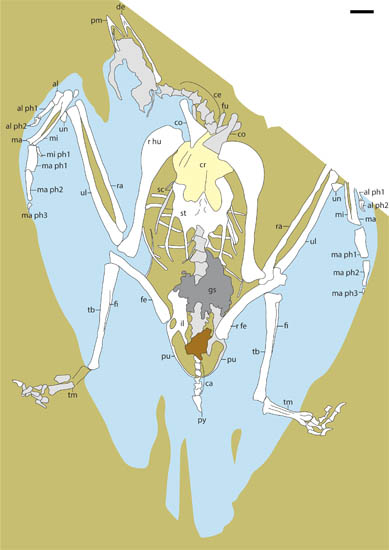In a new study published Jan 30 in Proceedings of the Royal Society B, a team of researchers from the Institute of Vertebrate Paleontology and Paleoanthropology (IVPP), Chinese Academy of Sciences, and Lingyi University in Shandong, has shown that a previously described specimen of Hongshanornis longicresta from the Shandong Tianyu Museum of Nature is actually a new species, which they name Eogranivora edentulata. This new species is a basal member of the Ornithuromorpha, helping to clarify trophic driven patterns of tooth loss within the Ornithuromorpha, and its apparent loss of the hallux may represent the first such occurrence in a Mesozoic bird and suggests a highly terrestrial lifestyle.
This important re-identification helps to clarify the evolution of the modern avian feeding apparatus, which is very specialized. On the exterior, living birds have a horny beak and toothless mouth. Internally, they have an oesophageal pouch mainly for storing food and a two-part stomach for more efficient digestion. Some birds that eat hard food items such as seeds, molluscs, and insects ingest stones (aka gizzard stones, hen’s teeth) to aid in breaking up their food.
Direct traces of diet are very rarely preserved in fossils and scientists usually have to make educated guesses concerning diet. However, this new toothless taxon is the only Cretaceous ornithuromorph to show direct evidence of herbivory, with seeds preserved directly in the birds eosophageal pouch indicating it was a granivore.
This discovery shows that the tooth loss characteristic of neornithines co-evolved with herbivory. In non-avian theropods the use of gizzard stones in digestion also correlates with herbivory and toothloss. “However, many Early Cretaceous birds preserve both teeth and ingested stones (gastroliths); we suggest that these birds were not herbivorous”, said study lead author ZHEN Xiaoting, Tianyu Natural History Museum of Shandong
The hallux is lost in a number of living birds, and Eogranivora may also be missing a toe, indicating it was terrestrial. This is the earliest known occurrence of digit loss in a bird.
“This new species is very exciting,” says Prof. Jingmai O’Connor of the IVPP, corresponding author of the study who made the identification. “When we thought this specimen was a Hongshanornis there was no clear pattern between diet and toothloss. With this re-identification everything makes sense and we reveal an interesting pattern in which gastroliths are widely utilized by ornithuromorphs but only those eating plants lose their teeth. Presumably teeth were still functional in birds with other diets.”

Fig. 1 Photograph of the main slab of the holotype of Eogranivora edentulata (STM35-3). Scale bar equals one centimetre. (Image by Jingmai O’Connor)

Figure 2. Line drawing of the main slab of the holotype of Eogranivora edentulata (STM35-3). Bones are indicated in white (or light grey if damaged); the crop is indicated in yellow, the gizzard is dark grey, and the unusual material preserved in the pelvis is indicated in brown. Feather impressions are indicated in blue and the matrix is tan. Scale bar equals one centimetre. (Image by Jingmai O’Connor)
Contact:
Jingmai K. O’Connor
Institute of Vertebrate Paleontology and Paleoanthropology
e-mail: jingmai@ivpp.ac.cn